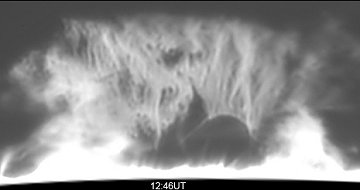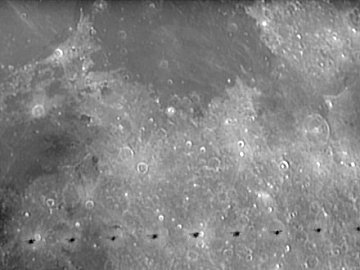 Did you sleep through the auroras of April? Next time get a wake-up call. Sign up for Spaceweather PHONE.
Did you sleep through the auroras of April? Next time get a wake-up call. Sign up for Spaceweather PHONE.
WHAT RHYMES WITH SUNSPOT? Solar activity comes in many forms. Tiny sunspot 871 poses no threat for strong solar flares--but it has produced a burst of poetry. "A nearly-blank sun still has something to say," points out astrophotographer and contributing poet Howard Eskildsen of Port Charlotte, Florida.
SOLAR PROMINENCE: Another fine prominence is dancing over the sun's limb, as shown in this April 18th photo from Harald Paleske of Langendorf, Germany:

Prominences are clouds of hydrogen held up by solar magnetic force fields. Fuzzy areas in the prominence are the natural fuzziness of clouds. Sharper features trace the magnetic lines of force. Because everything on the sun is so outlandishly big (Earth would fit through the gap in the bottom of the arch) details like these are easily seen through modest solar telescopes. If you have one, take a look.
more images: from Robert Arnold on the Isle of Skye, Scotland; from P-M Hedén of Vallentuna, Sweden; from Monty Leventhal of Sydney, Australia;
LUNAR TRANSIT: When the Moon rose over Athens, Greece, on the evening of April 14th, photographer Anthony Ayiomamitis was ready for an unusual event. With a rapid-fire series of exposures, he caught the International Space Station (ISS) passing directly in front of the Moon:

Not visible in Ayiomamitis's 9-photo composite is a Progress supply rocket flying just ahead of the ISS. "The rising moon was only 20 degrees in altitude," he explains. "The Progress was not visible due to poor seeing at that altitude." The silhouette of the massive space station, however, was dark and striking as it flitted by the Sea of Tranquillity, crossing the entire lunar disk in only 0.85 seconds. Ayiomamitis has also accomplished this challenging trick with the Sun.
Space station flyby alerts: SpaceWeather PHONE.

